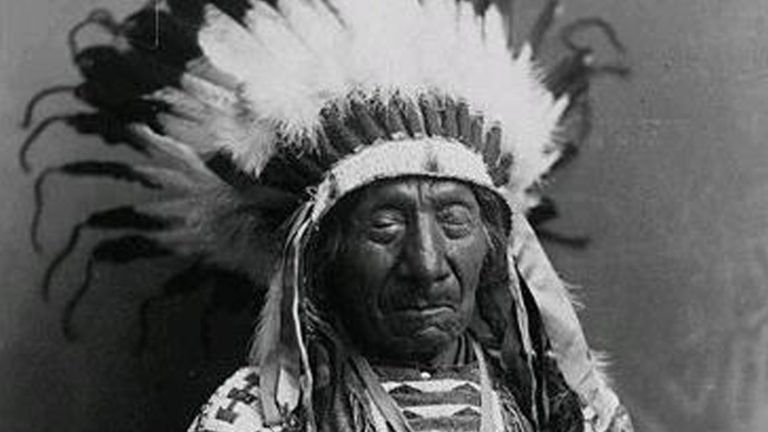In 1873 Red Cloud allowed himself and his band to be settled on the Red Cloud Agency near Camp Robinson, Nebraska. Many Sioux felt this action “sold out” his people to the United States government. Some of his warriors remained away from the Agency in support of Chief Crazy Horse and other Indian leaders still making war on the cavalry on the Northern Plains. In June of 1876, a large group of Lakota, Cheyenne and Arapaho warriors (including Red Cloud’s son Jack) wiped out the command of Brevet General George Armstrong Custer at the Battle of the Little Bighorn in Montana territory (Red Cloud and many of his followers were detained at their camp and accused of supporting the campaign).
Red Cloud, still retaining some influence over the warriors, persuaded Chief Crazy Horse to surrender at Fort Robinson. Some blamed him personally for Crazy Horse’s murder there in September of 1877.
Red Cloud, Spotted Tail, and other Indian leaders went to Washington in September of 1877 by invitation, met with then President Rutherford B. Hayes, and obtained a promise that the Oglala and Brule could pick their own place for permanent settlement within the reservation (which now excluded the Black Hills). Much maneuvering took place in Washington and within the tribes themselves. Red Cloud’s skillful handling of politicians, commissions, and of his own tribe, was key to the outcome. Congress finally passed legislation on June 20, 1878, allowing the establishment of the Pine Ridge and Rosebud agencies. A remarkable piece of statesmanship and leadership, it was the best the chiefs could do for their people, given the overwhelming circumstances.
Red Cloud agreed to relocate to the Pine Ridge Reservation in southwestern Dakota Territory in 1878. Once there he soon engaged in a much-publicized controversy with the agent, Dr. Valentine T. McGillycuddy though Red Cloud later acknowledged that much of what McGillycuddy wanted to do was in the best interests of the Sioux on the reservation.
Red Cloud continued his struggle with government agents in the 1880s in order to preserve the traditional authority of the chiefs. He fought against the Dawes Act of 1887-89 which divided tribal land into individual allotted tracts and took away half the Sioux land (of 1868) for use by whites. During this confrontation, he faced down General Crook,the government’s chief negotiator, at Pine Ridge in 1889.
Behind Red Cloud’s leadership, the majority of the Oglala stood firm against the agreement. Nevertheless, enough defections took place on other reservations that the required 75% approval was obtained. In 1888, Red Cloud invited the Jesuit Order to establish a school for Lakota children. This proved to be a wise decision because it kept Indian children on tribal land, and allowed them to be able to associate with their families and friends.
In 1890, Red Cloud discouraged participation in the Ghost Dance, trying to avert the troubles that led to the Wounded Knee Massacre. Despite all of his efforts, Red Cloud watched helplessly as his people’s culture and way of life eroded over the next thirty years.
Red Cloud had increasing difficulty with those younger members of the tribe who wanted to resume the warpath. They felt that he no longer was an effective leader. At the same time, there were those who felt that he was an obstructionist who impeded his people’s progress along the white man’s road. Both judgments have some validity. The noted frontiersman Captain James H. Cook observed that “during Red Cloud’s life, he and his people had to meet such conditions as never before had confronted his tribe.”

